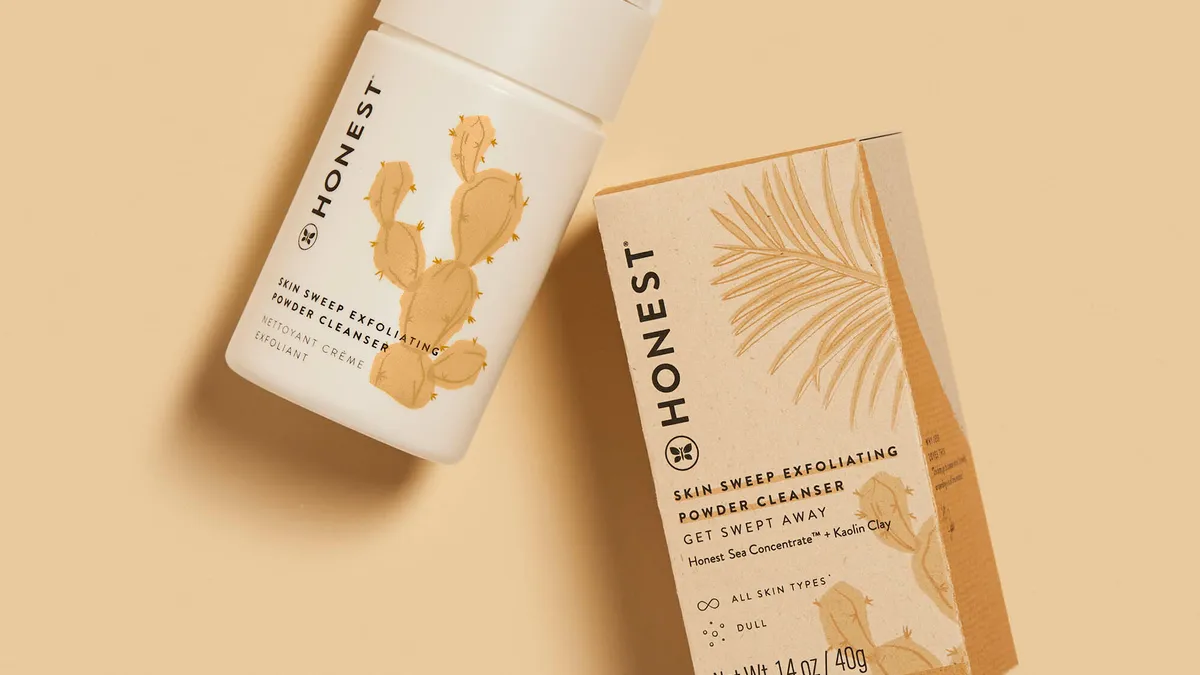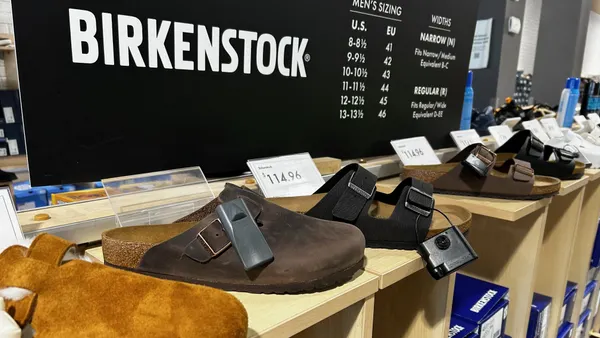Last month, Walmart announced that merchandise from two of its recent e-commerce acquisitions — quirky women’s apparel site Modcloth and menswear merchant Bonobos — would be sold on the Jet marketplace, but not on Walmart.com or in Walmart stores. It’s a strategy that differs widely from Target — which has also announced partnerships in recent months, including with popular online mattress company Casper and men's grooming subscription service Harry’s — where integration with the bullseye and outside logos is more the norm.
Both are strong plays to bring e-commerce strengths in house, and both are defensive moves against Amazon, which continues apace expanding merchandise in all categories. That's thanks in part to Amazon's Marketplace (which sells half the merchandise people buy there) and to an increasing number of brands that, as Nike decided this summer, are opting to sell directly on Amazon to boost their own direct-to-consumer sales. Amazon, for its part, hasn't shied away from buying expertise and infrastructure, most prominently via its recent acquisition of Whole Foods.
In the process, Walmart is ditching its flagship name to promote these new sub-brands while Target appears to be carefully pursuing partnerships — but not acquisitions — whose brands jibe with its own. There is rationale, and strengths and pitfalls, in each approach.
"Walmart and Target are approaching their alignment strategies around newly acquired brands and partnerships very differently," Kelly Jo Sands, executive vice president of marketing technology at marketing firm Ansira, told Retail Dive in an email. "A reason for this could be driven by the current differences in consumers’ perceptions of these flagship brands, and of the brands they’re acquiring."
Walmart versus Jet
For a while after Walmart bought Jet, a startup that hadn’t reached profitability and was still spending a lot to acquire customers, for $3.3 billion, many observers assumed the reason was Jet’s "secret sauce" algorithm — a neat tech trick that allows customers to drive down their final purchase costs by choosing various fulfillment methods, shipping speeds and return policies.
But in the months since, it’s become clear that Jet isn’t just a way for Walmart to expand its online chops, which had been dismal for years. The move has also provided the retail giant with a profusion of technology and retail expertise. And with Jet founder Marc Lore now at the helm of its U.S. e-commerce operations, the retailer has gobbled up a series of smaller e-commerce sites.
Just after the holidays last year, Walmart bought online shoe retailer Shoebuy, in a challenge to Amazon's Zappos, for $70 million and then continued its spree. In February, the company bought online outdoor retailer Moosejaw for $51 million in cash, in March announced the acquisition of vintage-inspired online women’s apparel Modcloth and in June bought menswear site Bonobos for $310 million. This month there were rumors that Walmart is also interested in acquiring beauty subscription service Birchbox, though both companies declined to comment to Retail Dive.
These players extensively expand Walmart’s customer base, said Ravi Jariwala, senior director of public relations at Walmart.com. But, though some brands may want to work with Walmart's new teams (which include executives from these online retailers) to feature some products at Walmart itself, he said, it's Jet that is the right fit for those brands with customers in demographic groups that don't generally frequent Walmart stores.
Walmart's average customer is less wealthy, less urban and quite a bit older than those typically shopping at Target and Amazon. Walmart has had difficulty in the past moving beyond that core base, even as it made what Keith Anderson, vice president of strategy and insights at retail intelligence firm Profitero, says were substantive changes to its culture and reputation, as when it meaningfully began elevating wages and employment opportunities.
"There’s a whole history of experiments at Walmart that almost universally failed, and I see the Jet acquisition and the quick string that came next, and possibly Birchbox, as a much bolder effort to basically buy customers," Anderson told Retail Dive. "You have these debates that have been going at that company for 20 years — similar debates have been going on at McDonalds and also other brands that are mainstream, but can’t reach a segment that they want to reach."
"The plan has been for Modcloth and Bonobos, for some of that product, to be sold through Jet because the demographics they serve are very nicely aligned."

Ravi Jariwala
Senior Director of Public Relations, Walmart.com.
While many were taken by surprise by the idea of Jet selling Modcloth and Bonobos merchandise, that was the idea all along, according to Jariwala. "The plan has been for Modcloth and Bonobos, for some of that product, to be sold through Jet because the demographics they serve are very nicely aligned," he told Retail Dive.
That's a wise move, according to Sands. Otherwise, Walmart risks driving away those sites' fans and driving down price expectations. "Walmart has positioned itself as being a low-cost retailer, winning on the battlefield of low prices and bulk value," she said. "This has caused some consumers to associate the Walmart name with lower quality for its personal brand and products like apparel. Although acquiring companies like Modcloth and Bonobos is opportunistic to reach new customers or gain share from current customers in a new way, these brands have a higher price points and perception of quality. In order to avoid driving down the price of these newly acquired brands and eroding their brand value, Walmart is very smartly distancing its name."
The brands may yet lose customers over its association with Walmart, even though loyalists still find merchandise only at the stand-alone sites or Jet. That appears to be happening to some extent, according to a report in the Los Angeles Times. "The thing I loved about Modcloth is that I knew the clothes I bought there couldn't be found at Macy's and weren't worn by the masses," Connie Warner, who has launched a Boycott ModCloth Facebook page, told the paper. "No more. I've unsubscribed from their emails. I refuse to shop at a store owned by Walmart."
"If they invest in personalization and customer experience for these brands, their loyal following will continue to grow."

Kelly Jo Sands
EVP, Marketing Technology, Ansira,
But that picture is overblown, Jariwala said. "We did see a vocal minority respond on social media, but the business performance has shown that there hasn't been a drop off in growth," he said. In fact, he reiterated what Bonobos co-founder Andy Dunn (now, like Lore, employed by Walmart) has told the media — that as rumors flew for weeks about Walmart buying the brand, sales growth and customer acquisition, far from declining, continued apace.
Plus, Walmart has much to give, Jariwala said, and experts agree. "The deep pockets and scaled distribution network Walmart brings will definitely help these brands — if they invest in personalization and customer experience for these brands, their loyal following will continue to grow," Sands said.
The pitfall of this strategy? It remains to be seen how long Walmart can continue to run two retail enterprises with such different personalities. "What makes sense about what they’re doing is that they obviously needed to accelerate their traction with those wealthier households," Anderson said. "I like where they seem to be landing, which is buying up a portfolio of largely sub-scale brands — well known among a certain segment. They’re using Jet as the primary brand to continue to build the credibility and awareness with some of those shoppers, and they can use all those brands they’ve acquired to drive them over to Jet. There’s some real opportunity. But on the flip side they can’t sustainably operate this portfolio of companies without synergy."
Target's picks on-brand partners
Then there's Target, which reportedly considered buying Casper Mattress outright for $1 billion, but settled on a partnership announced in May that has bedding and other products from the startup displayed and sold on its site and in stores. Casper is the latest in the retailer's long history of working with premium brands and trendy designers. Through its TechStars partnership, the company has also invested money and mentorship in other retail-oriented startups. Target has carefully cultivated merchandise differentiation for decades, since losing a bruising price war with Walmart in the 1980s that Target itself had initiated.
"Target has aligned itself with being trendy, fun and high quality — worth paying a little more for by their target market consumers," Sands said. "Partnerships they explore have complemented their positioning, with data reflecting similar consumers who already love the brands and adapting them for its personal stores, making Target more confident in closely aligning their name with its partnered brands."
It's not that Target doesn't win on price generally; however, its partnerships with fashion and interior designers like Victoria Beckham and Nate Berkus, among others, mean customers bulk up their carts with pricier things. "I don’t know that they really struggle to compete on price that way some people perceive them to," Anderson said. "Target does carry items closer to the 'better' and 'best' category, but on exactly the same item, Target really is competitive. People walk into Walmart and walk out pleased about the prices, and people walk into Target and walk out with things they hadn’t planned on buying, so they perceive Target as more expensive."
"Target was always known for design, earning the moniker 'Tar-zhay.' Their new streak appears to be focused on re-energizing that."

Maya Mikhailov
CMO and Co-founder, GPShopper
In addition to partnerships with designers and brands, Target is working hard to bolster its own brands, with plans to roll out 12 new labels over the 18 months, using the same research and design approach applied to developing its successful new Pillowfort and Cat & Jack kids lines. "I think their goal is to build their in-house brands more," Maya Mikhailov, chief marketing officer and cofounder of GPShopper, told Retail Dive. "Target was always known for design, earning the moniker 'Tar-zhay.' Their new streak appears to be focused on re-energizing that. It seems to be a natural extension of what their original brand promise was."
But Target has so far stayed away from acquisitions, although Target Chief Information and Digital Officer Michael McNamara recently told the Wall Street Journal that "thinking about possible mergers and acquisitions is something we do every day as a regular course of business." The company earlier this month announced the purchase of same-day delivery company Grand Junction, which Anderson calls "a promising sign that Target at least knows they need to do more than they are."
"They just don’t have their strategy fully baked," he said. "And they have some constraints. They don’t have the same flexibility that Walmart does. They don’t have as much capital at the moment to make the really bold M&A plays. Even if Target figures out what they should do, somebody like Walmart or Jet will find a way to lock shoppers in that should have been Target shoppers, or were Target shoppers."
Indeed, Target is aiming for a small slice of consumers, if highly desirable ones, that, unfortunately for Target, overlaps with Amazon's formidable Prime membership base, says Matt Sarget, senior vice president of retail at Frank N. Magid Associates. The good news is that those same shoppers, unlike Walmart shoppers who tend to focus on price and convenience, are happy to shop at different retailers.
And it's not only that Target is smaller than Walmart, a retailer that generated $308 billion in revenue last year, not including its marketplace sales. (Target's was closer to $70 billion.) And Amazon, whose $145 billion in gross merchandise volume by Bloomberg Intelligence's measure, which does include third-party sales, pales to Walmart's but enjoys the financial support of its AWS cloud services unit. Rather, the clue to Target's restrained acquisition strategy may lie north of the border, according to retail analyst Nick Egelanian, president of retail development consultants SiteWorks International.
"They got hurt far more than people realize in Canada," he told Retail Dive of the retailer's failed entry and swift exit out of that country, which cost some $5.4 billion in pre-tax losses. "They're not really building stores except for small number of urban and college, not enough to move the meter. They sold their pharmacy business. They're as good a company as they always were in terms of concept. I think they’re capital constrained and damaged."
Target versus Walmart versus Amazon
Which one beats Amazon, the robust Walmart-Jet hydra, or the constrained, but on-brand Target differentiator?
That remains to be seen, said Egelanian, who warns that any retailer focusing too much on e-commerce will likely lose. "The internet is very disruptive," he said. "You have to be in it, not necessarily to make a lot of money in it, but as part of a multifaceted strategy and then the omni-strategy has to be profitable. If you’re expecting every aspect to be profitable, and the best model we have is Amazon, which is not profitable, you're asking a lot of yourself."






















